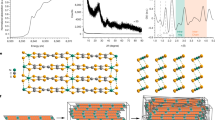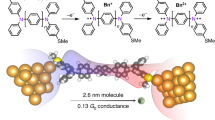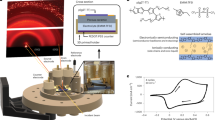Abstract
Organic molecules can self-assemble into well-ordered structures, but the conductance of these structures is limited1,2,3, which is a disadvantage for applications in molecular electronics. Conductivity can be improved by using coordination polymers—in which metal centres are incorporated into a molecular backbone—and such structures have been used as molecular wires by self-assembling them into ordered films on metal surfaces4. Here, we report electrically conductive nanoribbons of the coordination polymer [Pt2I(S2CCH3)4]n self-assembled on an insulating substrate by direct sublimation of polymer crystals. Conductance atomic force microscopy is used to probe the electrical characteristics of a few polymer chains (∼10) within the nanoribbons. The observed currents exceed those previously sustained in organic and metal–organic molecules assembled on surfaces by several orders of magnitude and over much longer distances. These results, and the results of theoretical calculations based on density functional theory, confirm coordination polymers as candidate materials for applications in molecular electronics.
This is a preview of subscription content, access via your institution
Access options
Subscribe to this journal
Receive 12 print issues and online access
$259.00 per year
only $21.58 per issue
Buy this article
- Purchase on Springer Link
- Instant access to full article PDF
Prices may be subject to local taxes which are calculated during checkout





Similar content being viewed by others
References
Lafferentz, L. et al. Conductance of a single conjugated polymer as a continuous function of its length. Science 323, 1193–1197 (2009).
Choi, S. H., Kim, B. & Frisbie, C. D. Electrical resistance of long conjugated molecular wires. Science 320, 1482–1486 (2008).
Song, F. et al. Direct measurement of electrical conductance through a self-assembled molecular layer. Nature Nanotech. 4, 373–376 (2009).
Tuccitto, N. et al. Highly conductive ∼40-nm-long molecular wires assembled by stepwise incorporation of metal centres. Nature Mater. 8, 41–46 (2009).
Tans, S. J. et al. Individual single-wall carbon nanotubes as quantum wires. Nature 386, 474–477 (1997).
Dai, H. Carbon nanotubes: synthesis, integration and properties. Acc. Chem. Res. 35, 1035–1044 (2002).
Seeman, N. C. DNA in a material world. Nature 421, 427–431 (2003).
Porath, D., Cuniberti, G. & Di Felice, R. Charge transport in DNA-based devices. Top. Curr. Chem. 237, 183–227 (2004).
Berlin, Y. A. et al. DNA electron transfer processes: some theoretical notions. Top. Curr. Chem. 237, 1–36 (2004).
Kitagawa, S. & Noro, S. in Comprehensive Coordination Chemistry II Vol. 7 (Elsevier, 2004).
Kitagawa, H. et al. Charge ordering with lattice distortions in a conductive MMX-chain complex, Pt2(dta)4I (dta = CH3CS2−). J. Am. Chem. Soc. 121, 10068–10080 (1999).
Bera, J. K. & Dunbar, K. R. Chain compounds based on transition metal backbones: new life for an old topic. Angew. Chem. Int. Ed. 41, 4453–4458 (2002).
Dustin, K. J. & James, M. T. Molecules as wires: molecule-assisted movement of charge and energy. Top. Curr. Chem. 257, 33–62 (2005).
Welte, L. et al. Time-dependence structures of coordination network wires in solution. ACS Nano 2, 2051–2056 (2008).
Bellitto, C., Flamini, A., Gastaldi, L. & Scaramuzza, L. Halogen oxidation of tetrakis(dithioacetato)diplatinum(II) complexes, Pt2(CH3CS2)4—synthesis and characterization of Pt2(CH3CS2)4X2 (X = Cl, Br, I) and structural, electrical, and optical-properties of linear-chain (μ-iodo)tetrakis(dithioacetato)diplatinum, Pt2(CH3CS2)4I. Inorg. Chem. 22, 444–449 (1983).
Calzolari, A., Alexandre, S. S., Zamora, F. & Di Felice, R. Metallicity in individual MMX chains. J. Am. Chem. Soc. 130, 5552–5562 (2008).
Olea, D. et al. MMX polymer chains on surfaces. Chem. Commun. 1591–1593 (2007).
Welte, L. et al. Organization of coordination polymers on surfaces by direct sublimation. Adv. Mater. 21, 2025–2028 (2009).
Gomez-Navarro, C. et al. Contactless experiments on individual DNA molecules show no evidence for molecular wire behavior. Proc. Natl Acad. Sci. USA 99, 8484–8487 (2002).
de Pablo, P. J. et al. Nonlinear resistance versus length in single-walled carbon nanotubes. Phys. Rev. Lett. 88, 36804–36808 (2002).
Johnson, K. L. Contact Mechanics (Cambridge Univ. Press, 1985).
Kaiser, A. B. Systematic conductivity behavior in conducting polymers: effects of heterogeneous disorder. Adv. Mater. 13, 927–941 (2001).
Gomez-Navarro, C. et al. Tuning the conductance of single-walled carbon nanotubes by ion irradiation in the Anderson localization regime. Nature Mater. 4, 534–539 (2005).
Dreizler, R. & Gross, E. K. U. Density Functional Theory (Plenum Press, 1995).
Car, R. & Parrinello, M. Unified approach for molecular-dynamics and density-functional theory. Phys. Rev. Lett. 55, 2471–2474 (1985).
Datta, S. Quantum Transport in Mesoscopic Systems (Cambridge Univ. Press, 1995).
Springborg, M. & Dong, Y. Metallic Chains/Chains of Atoms (Elsevier, 2007).
Horcas, I. et al. WSxM: a software for scanning probe microscopy and a tool for nanotechnology. Rev. Sci. Instrum. 78, 013705 (2007).
Acknowledgements
The authors acknowledge financial support from the Spanish Ministerio de Educación y Ciencia (Projects MAT2007-66476-C01/02), CAM (S-0505/MAT/0303), the European Union (FP6-029192 DNA-NANODEVICES and ERA under Chemistry Program CTQ2006-027185-E) and the regional Emilia Romagna net-lab PROMINER. The authors are indebted to A. Guijarro and M. Moreno-Moreno for their help in the experiments. Discussions with J.M. Soler and D. Porath are also acknowledged.
Author information
Authors and Affiliations
Contributions
L.W. conducted the experiments. A.C. planned and performed the DFT calculations. R.D.F. designed the theoretical work and prepared the manuscript. F.Z. and J.G.-H. designed the experiments, analysed the data and prepared the manuscript.
Corresponding authors
Ethics declarations
Competing interests
The authors declare no competing financial interests.
Supplementary information
Supplementary information
Supplementary information (PDF 582 kb)
Rights and permissions
About this article
Cite this article
Welte, L., Calzolari, A., Di Felice, R. et al. Highly conductive self-assembled nanoribbons of coordination polymers. Nature Nanotech 5, 110–115 (2010). https://doi.org/10.1038/nnano.2009.354
Received:
Accepted:
Published:
Issue Date:
DOI: https://doi.org/10.1038/nnano.2009.354
This article is cited by
-
Macro- and atomic-scale observations of a one-dimensional heterojunction in a nickel and palladium nanowire complex
Nature Communications (2022)
-
Deep Learning Method to Accelerate Discovery of Hybrid Polymer-Graphene Composites
Scientific Reports (2021)
-
Tunable two-dimensional interfacial coupling in molecular heterostructures
Nature Communications (2017)
-
Origin of multiple band gap values in single width nanoribbons
Scientific Reports (2016)
-
Solvent induced rapid modulation of micro/nano structures of metal carboxylates coordination polymers: mechanism and morphology dependent magnetism
Scientific Reports (2014)



